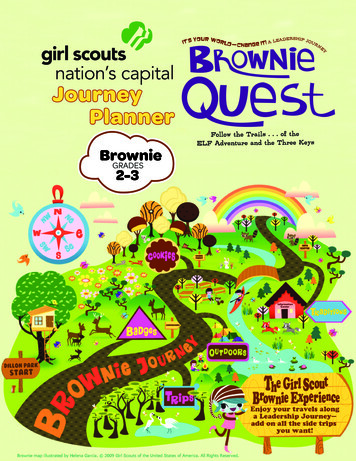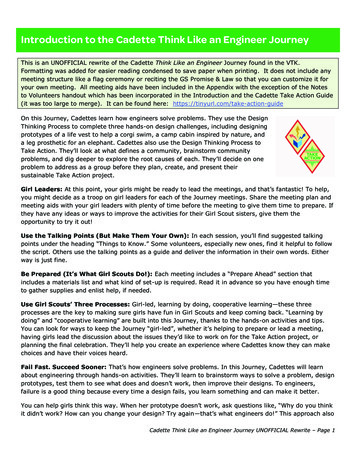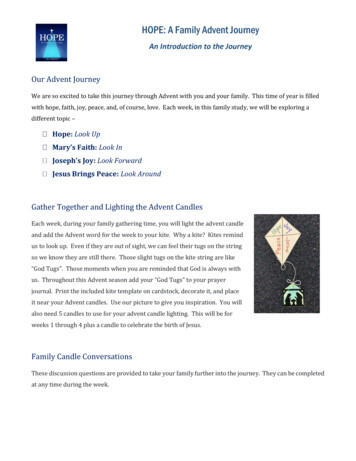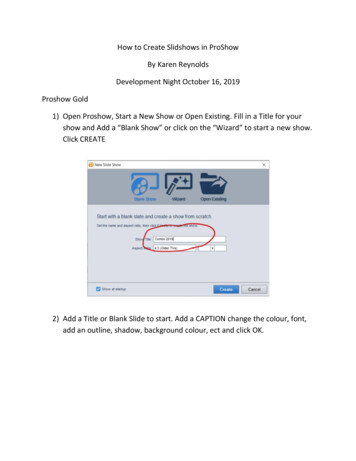
Transcription
JourneyCOMPANION GUIDE NOTEBOOK
2
Table of ContentsABOUT HOPE FOR THE JOURNEY4LETTER FROM SHOW HOPE’S FOUNDERS5AN INTRODUCTION TO TRUST-BASED RELATIONAL INTERVENTION (TBRI )6PRACTICAL APPLICATION: AN INTRODUCTION TO TBRI8CONNECTING PRINCIPLES10PRACTICAL APPLICATION: CONNECTING PRINCIPLES12EMPOWERING PRINCIPLES14PRACTICAL APPLICATION: EMPOWERING PRINCIPLES16CORRECTING PRINCIPLES18PRACTICAL APPLICATION: CORRECTING PRINCIPLES22THE GOSPEL TBRI24PRACTICAL APPLICATION: THE GOSPEL TBRI26TRAUMA COMPETENCY CONTINUUM29CONFERENCE NOTES30ACKNOWLEDGEMENTS42This Companion Guide Notebook is intended for use by participants of Show Hope’s Hope for the Journey Conference.3
ABOUTJourneyIn an effort to address the knowledge barrier to adoption, Show Hope launched its Pre Post Adoption Support workwith the aim of further supporting children and families impacted by adoption and/or foster care through practicalresources and tools for their journeys ahead.Growing out of that desire, Show Hope premiered its Empowered to Connect Conference in August 2010. From theearly days, Show Hope had the privilege of connecting and collaborating with Dr. Karyn Purvis, the co-founder of theKaryn Purvis Institute of Child Development at TCU and co-creator of Trust-Based Relational Intervention (TBRI), alongwith Michael and Amy Monroe, who co-authored “Created to Connect” with Dr. Purvis.In May 2020, building on this legacy, the Hope for the Journey Conference was introduced. Created and curated fortoday’s busy parents and caregivers, the Hope for the Journey Conference is customizable in nature, making it easilyconsumable in a one-day setting or through multiple touchpoints over weeks. The conference’s shared informationis also succinct and accessible for parents and caregivers meeting the needs of children impacted by adoption andfoster care as well as the churches and organizations that are working to support them.The Hope for the Journey Conference includes five high-level learning modules (outlined below) with opportunitiesto go deeper into select topics. Show Hope is grateful to the adult adoptees and foster and adoptive families whohave been willing to share with us through the “Practical Perspectives” video segments. By incorporating their voicesand highlighting their stories, our desire is for children and families impacted by foster care and adoption to beencouraged to find hope for their own journeys. Learning Module 1: An Introduction to Trust-Based Relational Intervention (TBRI)» “Going Deeper” topic to include the importance of understanding ACEs. Learning Module 2: Connecting Principles» “Going Deeper” topic to explore connecting with teens. Learning Module 3: Empowering Principles» “Going Deeper” topic to unpack sensory needs and integration. Learning Module 4: Correcting Principles» “Going Deeper” topic to include a review of The IDEAL Response . Learning Module 5: The Gospel TBRI» “Going Deeper” topic to discuss the local church’s role in trauma-competent care.4
Letter FromSHOW HOPE’S FOUNDERSDear Friends,Welcome to Hope for the Journey! It is an honor to know you have chosen to be with us here atShow Hope. As you begin this time, know that we SEE you. Your days are filled—balancing andjuggling the demands of parenting, marriage, community, home, work, and more—leaving little tono time for yourself and much-needed respite. You are not alone.As we outlined here last year, the aim of the Hope for the Journey Conference is simple: to shepherdparents and caregivers to a deeper understanding of their children’s needs. By introducing robustresources and sharing practical experiences of successes and failures of the day-to-day (let’s behonest parenting is hard!), it is our prayer that parents and caregivers will leave encouraged asthey continue to journey well with their children.We founded Show Hope more than 19 years ago, and we continue to stand on the foundationaltruth that humanity bears the image of God. These precious souls who are, ultimately, His havebeen entrusted to you by Him, and you have the awesome privilege of loving them, caring forthem, and serving them. And while we must be clear-eyed about the hard circumstances that havebrought our children to us, we must also remain hopeful, knowing that by Christ all things werecreated and in Him all things hold together.Thank you for choosing to be here with us! We pray that it is a balm as well as a taste of God’s graceand goodness.Together, let’s SEE where hope goes,Mary Beth & Steven Curtis ChapmanFoundersShow Hope5
An Introductionto TBRITrust-Based Relational Intervention (TBRI) is a care model designed to help meet relational anddevelopmental needs of children and youth impacted by trauma. TBRI considers the whole child—his or her brain, biology, behavior, body, and beliefs—and provides parents and caregivers withpractical tools and insight to help their child(ren) reach his or her highest potential. And, perhapsmost integral, TBRI has connection at its core—the truth that connection builds trust, and trustbuilds healthy relationships.Five B’s of Relational TraumaBRAIN, BIOLOGY, BEHAVIOR, BODY, BELIEFSThe TBRI model is built upon three guiding principles: Connecting Principles: Create connections that disarm fear, gain trust, and enhance learning. Empowering Principles: Strengthen learning and regulation by meeting a child’s physical andenvironmental needs. Correcting Principles: Shape beliefs and behaviors effectively, so children feel safe, protected, andempowered.6
Children who have experienced complex trauma need parents andcaregivers who are insightful, prepared, equipped, and committed.As Dr. Karyn Purvis once said, “All children need to know that they’reprecious and unique and special. But a child [who has experiencedtrauma] needs to know it more desperately.”The human brain is like a two-story house. The “upstairs brain” allowsus to think, reason, learn, remember, and regulate our emotions andis mostly unwired at birth. It takes time and experience for the upstairsbrain to become hardwired.The “downstairs brain” is mostly wired at birth and allows a newborn toeat, sleep, drink, stay warm or cool, and eliminate. A newborn’s reflexesand basic bodily functions are rooted spectfulWhen a child experiences trauma, it can impact thewiring and chemistry of the brain—the lower, moreprimitive parts of the brain can overdevelop fromreactions to fear while the more sophisticated, upstairsbrain remains underdeveloped.Repeating nurturing experiences can strengthen theupstairs brain, so it can help regulate the downstairsbrain, strengthening the balance between the two partsof the brain.If a child spends too much time in fear, the brainorganizes itself around the survival response—fight,flight, or freeze—and the downstairs brain runs the show.Without felt safety and the ability to trust, the moresophisticated functions of the upstairs brain are largelyinaccessible to a child. This is why the TBRI approach toaddressing early trauma is vitally important.ACEsConsidering the impact of adverse childhood experiences (ACEs) can provide a window into thedevelopmental impact of relational trauma and possible physical and mental outcomes. Examples of ACEsinclude emotional abuse, physical abuse, substance abuse, mental illness, domestic violence, criminalbehavior, divorce, separation, and/or the death of a parent or loved one.To download an ACEs questionnaire, visit the Resources page at showhope.org/hopeforthejourneyresources.7
Practical Application: An Introduction to TBRIGuiding ThoughtAs we provide emotional, physical, and spiritual safety for our kids we create space for hope and healing.— Tona OttingerQuestions & Reflections As you consider how your needs were met as a child, what gave you a sense of belonging, feltsafety, and trust? If those needs for security were not met, what might have disrupted thosefeelings of connectedness and felt safety? What are some needs that might have gone unmet for your child in his or her past? What can youdo to meet those needs now? How does remembering the impact of stress and trauma change the way you view and engageyour child’s behavior? As you consider your current parenting strategies, what may need to be adjusted to bettercommunicate care, security, and safety to your child(ren)?Tips & Reminders Relational trauma impacts beliefs about the self, including self-awareness, self-regulation, self-esteem, and self-efficacy. Use character praise to help change your child’s belief system abouthimself or herself by recognizing his or her character traits. Some examples include:» “I love playing with you! You are so much fun.”» “Thank you for sharing. You are really thoughtful.”» “You are so creative. That is such a great idea!” Positive experiences are essential for rewiring the brain while also contributing to the mind’soverall health. Each week, look for opportunities to introduce a new, positive experience in the lifeof your child or teenager. Include activities where engagement strategies (eye contact, healthytouch, behavior matching, play) can be incorporated to further build connection and felt safety.» Have a family dance party.» Paint together. (For littles, start with rocks, and for your older children, try pottery.)» Explore together a new park or area of town where you can play, snap photos, or just beoutdoors as a family.8
Action PointsCrossing the MidlineCross-lateral movement refers to any time one side of the body crosses over themidline of the body to the other side. The right side of the body is controlled bythe left side of the brain, and the left side of the body is controlled by the right sideof the brain. Practicing crossing the midline is a great way to get the right and leftsides to communicate optimally. Ideas for younger children—that are also fun—include classic games like “Hot Potato” (but you must hold the object with bothhands), clapping games like “Miss Mary Mack,” and “Simon Says.” For older childrenand teens, consider tennis, baseball, or softball; washing a car together (which alsopromotes connectedness); and even a game of Twister.Family Game NightCard games (UNO, Go Fish), board games (Monopoly, Operation), chess, checkers,and puzzles are great opportunities to exercise the brain to help improve attention,coordination, concentration, planning, and more. Incorporate regular (weekly orbimonthly) family game nights for everyone in your home, keeping in mind varyingskills and abilities. It can become a fun tradition and an excellent opportunity tofoster connection as a whole family.9
ConnectingPrinciplesGoal: To build trusting relationships that help children and youth feel valued, caredfor, safe, and connected. Disarming fear and building trust greatly increase thecapacity for connection, growth, and learning.SecureAttachment Says:I feel protected.I feel precious.I feel heard.My physical needs aretaken care of.My emotional needs aretaken care of.10
Mindfulness StrategiesSelf-Awareness Strategies Identify the thoughts, beliefs, and behaviors you bring to relationships based on the care you received.Realize how these thoughts, beliefs, and behaviors influence your relationships.Identify personal triggers.Practice regulating yourself during times of stress:» Pray.» Take 10 deep breaths.» Go for a walk.Stay calm and emotionally present during a child’s distress. This allows you to:» Think flexibly.» Solve problems creatively.» Model compassion.» Co-regulate with your child.Attunement Strategies Be flexible in responding. Adjust your interactions based on your child’s or teen’s needs anddevelopmental abilities. Be aware of your child’s or teen’s perceptions of your voice/presence/interactions (i.e. arethey seen as welcoming, threatening, etc.?). See the need beneath the behavior. Meet the need.Engagement Strategies Use an appropriately authoritative voice—a blend of structure and nurture, never weak,shaming, or harsh. Value eye contact (but never force):» “Can I see your eyes, please?”» “I love seeing those beautiful eyes!” Match your child or teen’s posture, and voice. Incorporate healthy touch (with permission):» Chin prompt» Hand on shoulder» Hugs» High fives or fist bumps Interact playfully:» Play games.» Be silly together.» Use imaginative play.Be aware of yourself, your child, and the environment. Be a calm, attentive presence.11
Practical Application: Connecting PrinciplesGuiding ThoughtWhen you connect to the heart of a child, everything is possible.— Dr. Karyn PurvisQuestions & Reflections As you consider your childhood, what from your past might hinder the connection between you andyour child? In times of stress, remember, It is my job to help my child regulate. What are some proactive strategiesthat will help you remain calm and present in those moments? Remaining flexible is critical to your son or daughter’s mental and emotional health. In what situationscan you give more “yeses”? Why is it sometimes challenging to see beyond your child’s behavior and recognize the underlyingneed he or she is trying to express or have met? Consider proactive strategies like identifying yourpersonal triggers to better see the need your child is expressing.Tips & Reminders Be fully present.» “Stop” what you are doing.» “Look” into his or her eyes.» “Listen” to his or her words, and empathize with the joy or pain your child is expressing. Make it a priority to incorporate healthy touch (with permission) in your child’s daily activities andinteractions to help build connection and disarm fears.12
Action PointsDaily FavoriteFor dinnertime or at the end of each day, spend time where each family membershares one “favorite” thing from his or her day. Remember, positive experiences areessential to rewiring the brain. Celebrate together that one thing—no matter how big orsmall—and share in each member’s joy. It is an easy way to foster connection and focuson gratitude together as a family.Behavior MatchingMatching your child’s or teen’s posture, and voice can be effective in buildingconnection and fostering felt safety. It’s an engagement strategy that really validatesyour child or teen and his or her expressions and passions. For younger children, it canbe as simple as joining them in building blocks and copying their creations. For teens,it can be playfully mimicking their use of slang, body language, and tone. Behaviormatching can also be an easy opportunity to incorporate other engagement strategieslike eye contact and healthy touch—always with permission.13
EmpoweringPrinciplesGoal: To prepare bodies and brains for success by meeting the environmental andphysical needs of children and youth.One of the most important outcomes of Empowering Principles is to teach the capacity for regulation.These skills can be taught through modeling; practicing co-regulation; and by using physical exercises,daily routines, and/or nurturing activities. The goal is to give children the tools needed to use theirbrains and bodies to keep their internal states regulated and balanced. This is learned through healthyrelationship.Our own personal past experiences and history will influence how we perceive a new experience. The braindevelops in sequence and will heal in sequence. Therefore, a child’s ability to access any part of his or herbrain that is not fully developed due to age or traumatic influence will be impaired.14
Physiological (Physical/Internal) Strategies Have your child’s or teen’s physical needs been met?» Manage sleep, hydration, and blood sugar.» Meet nutritional needs.» Engage sensory needs by providing physical activity, at least, every two hours.» Teach regulation by modeling and practicing regulation skills in physical and/ornurturing activities throughout the day.Ecological Strategies How is the environment affecting your child or teen? In what ways can you modify theenvironment to help your child?» Use daily rituals that are predictable. Create morning and evening routines and stick to these.» Foster and model predictability in transitions (i.e. “in five minutes, we will ”).» Develop an awareness about levels of sensory input—both for those who are sensoryseeking and those who are sensory averse. Consider noise levels, unfamiliar or strong odors, lighting, and so forth.To download a list of resources and sensory integration tools, including some of our favorite fidgets,visit the Resources page at showhope.org/hopeforthejourneyresources.15
Practical Application: Empowering PrinciplesGuiding ThoughtGiving a child a voice is one of the most powerful tools we can give.— Dr. Karyn PurvisQuestions & Reflections Think of a time when you were safe, but you didn’t feel that way. Consider situations in which yourchild or teen may not feel safe. How does he or she respond to fear? Describe a time when you misunderstood a fear-driven response as manipulation, control, or willfuldisobedience. Help your child navigate change by creating predictability. Doing so will encourage felt safety. Thinkabout the transitions that are most difficult (i.e. bedtime, school drop off, technology limits). What aresome strategies you can use to support your child or teen in transitioning well? What are some ways you can modify your environment to support your child’s sensory needs (i.e.lights, smells, noises, sensory-rich or sensory-sensitive environments)?Tips & Reminders Dr. Karyn Purvis was also known as the “Queen of Bubblegum.” Chewing and sucking are both calmingengagements, so do not shy away from giving your son or daughter a piece of gum or candy indysregulated situations. Exercise, physical activity, hydration, and healthy snacks are critical for children, teens, and adults, andall promote healthy brain development and regulation. Go for walks together, consider weekend hikes,or find sports you can play as a family. Have water readily available along with healthy snacks for anytime of the day.16
Action PointsTransition FormulaOne way to empower your children for success is by utilizing this formula fortransition from one activity to the next.Attention Mention Distract Act Successful TransitionFirst, get your child’s attention by being in front of him or her with direct eyecontact; then mention what is going to happen. For example, “In three minutes,it will be time for bed. When I come back, I am going to say, ‘It’s time for bed,’ andyou will say, ‘OK, Mom (or Mommy).’ Sound good?” When it is time to make thetransition, try a “connected distraction” (i.e. playful eye contact, healthy touch,etc.). The goal is to distract your child or teen from his or her activity and get himor her connected to you. Once you feel connected, stay with him or her until thetransition is successful.Alerting and OrganizingThere are times when our brains and bodies are running slow (lethargic, unaware),and there are times when they are running too fast (hyperactive, lacking focus).Whether your child’s or teen’s brain and body are running too slow or too fast,these activities can bring regulation, relaxation, and even focus. Jumping (rope, trampoline, exercises) Chair, desk, and/or wall pushes Safe pillow fights or crashing into a pile of pillows (i.e. “Crash and Bump”)17
CorrectingPrinciplesGoal: To help children learn appropriate strategies for getting their needs met and tolearn to navigate successful interactions throughout their day.Hallmarks of Connected Parenting Time-ins vs. Time-outs Compromises vs. Consequences Problem-solving vs. Lectures Advocacy stance vs. Adversary stance Focus on your child’s preciousness vs. Focus on his or her failuresCorrecting Princip le: The IDEAL Response» Immediate: Respond immediately.» Direct: Engage directly (with eyes, proximity, and touch when possible).» Efficient: Maximize playfulness when possible, and use only the Level of Response thatis essential for addressing the challenge.» Action-Based: Give your child a chance for a “redo.” Maximize learning by creatingbody memory for the right choices.» Leveled: Direct at the behavior, not the child. Make it clear to your child that you are hisor her advocate, not adversary.18
Solving behavioral challenges quickly and effectively while building connection between the parent orcaregiver and child is a primary feature of TBRI.Foundational to TBRI is the premise that most behavior is driven by unmet needs. Ask yourself thefollowing questions when your child or teen is using behavior to communicate something he or she doesn’thave the words to express: What is this behavior really saying?What does your child actually need?How can I teach my child to get his or her needs met?How can I teach this skill at a calmer time?To help disarm fear and negative behaviors in children or teenagers who are being disruptive, considerasking questions like: Can you tell me what you need? How can I help you?Correcting Princip le: Levels of Response Level 1: Playful EngagementChallenge: This is a low-level challenge in which your child is disrespectful or dysregulated in some way.He or she may roll his or her eyes, speak withoutraising his or her hand, grab something withoutyour permission, etc.At this level, there is no threat of danger orphysical harm.Opportunity: Tremendous learning can occur atthis level of intervention because the response canstill be playful.Children learn at this level if the adult is consistent.In TBRI-informed environments where adultsare connecting, empowering, and teachingproactively, 70 to 80 percent of challengingbehaviors can be addressed at this level.Goal: Simply give your child an opportunity to “redo” the behavior. Since motor memory is formedthrough active participation, deep learning occurs.19
Level 2: Structured EngagementChallenge: This is a higher-level challenge and/or one that was not resolved with Playful Engagement. Noone is in danger, and there is no physical threat. But if mishandled, there is a potential for escalation.At this level, the adult should provide additional attention and structure.Opportunity: Learning can still occur at this level because your child’s fight-flight-freeze system is not fullyactivated.Although it may take a couple of minutes, this is still a great win for both you and your child.Situation:Your child or teen refuses to clean his or her room.Response: You will need to clean your room, but you can do itnow or after lunch. Which do you choose?When it’s over, it’s over! (The goal is to demonstrate tothe child that his or her value is not defined by the episode.)Immediately return to Level 1: Playful Engagement.Goal: Providing “choices” gives the child or teen a sense of safety and active participation in theresolution. Again, give the child an opportunity to “redo” the behavior, which contributes tomotor memory and deep learning.Level 3: Calming EngagementChallenge: At this level, the challenge is escalated, and your child may be at risk of becoming violent. Youmust remain laser-focused and attentive in order to help your child de-escalate.Opportunity: An unexpected opportunity arises out of this more significant level of challenge because yourchild can see your commitment to help him or her through this “hard place.”Handled correctly, a Level 3 challenge can become a tremendous opportunity for connection and growth.Again, when it is over, it’s over! Return to Level 1: Playful Engagement.You must remain calm and focused. Your voice should be firm but not threatening. Use fewer words, andtalk more slowly because cognitive areas of the brain are less active during periods of fight-flight-freezeresponses.Note: When the child has returned to a calm state, a redo can be requested when possible. Only request aredo to encourage learning, never to shame or punish.Goal: Support your child’s or teen’s need to regulate. Another goal is to prevent a full-blown crisis.20
Level 4: Protective EngagementChallenge: At this level, there is an active threat of danger and/or physical harm. Protection must beprovided for your child or teen as well as others who are nearby.Opportunity: The most powerful message you can give your child or teen is the knowledge that you cankeep him or her safe and that you know your child’s behavior is not what defines him or her.Situation:Your child becomes physically or verbally threatening and/or begins abehavioral meltdown, doing damage to property or persons nearby.Response: Remove either your child or those in close proximity. If necessary,seek help from an adult who can stay with other children while you stay withyour child who is struggling to regulate. Find a private, quiet space where yourchild can be kept safe and is not alone. Remove objects that might becomeharmful to your child or others.Goal: The immediate goal is to provide safety for all who are involved, including your child.Remember, particularly in Protective Engagement situations, the goal is to demonstrate to your child orteen that his or her value is not defined by the episode. As time allows (which may take days or weeks),look for opportunities to process the event(s) with your child or teen to foster greater connection.21
Practical Application: Correcting PrinciplesGuiding ThoughtIt is better to err and repair than to have never erred at all.— Dr. David CrossQuestions & Reflections How could you “practice outside the moment” to help create a new pattern of behavior or interaction—for both you and your child? Which elements of the IDEAL Response come more naturally to you? Which elements do you strugglewith and why? When thinking about calming engagement, what helps you regulate and calm? What helps your childregulate and calm? As you consider your current strategies, how can you correct while staying connected and buildinggreater trust with your child or teen?Tips & Reminders Implement behavioral scripts—the actions of a trauma-informed culture that seek to reduce escalationand teach self-regulation skills.» Choices (“You have two choices”—choices given are never threats or punishments.)» Compromises (“Would you like a compromise?”)» Behavioral Re-Do’s (“Can you try that again with respect?”) Take a deep breath. Breathing deeply will oxygenate the body and brain, helping children andteens (and you!) think more clearly, learn more easily, calm down, and make better behavioralchoices.22
Action PointsLife Value TermsCommon in TBRI and trauma-informed cultures, Life Value Terms create an effective,efficient mode of communication that avoids lengthy lectures and can be used in timesof stress or dysregulation. We encourage you to develop your own Life Value Terms,suited for your daily interactions with your child or teen. Consider even posting theseon your refrigerator or a common space in your home. The following are some ideas toget you thinking as you develop ones for your family.» “Gentle and Kind”» “Using Words”» ”Accepting ‘No’”» “With Permission and Supervision”» “With Respect”For the Everyday The “TBRI Mantra”, as coined by Dr. David Cross, is one to think through, memorize,and call to mind on a daily basis.» Stay Calm (No Matter What).» See the Need (Behind the Behavior).» Meet the Need (Find a Way).» Don’t Quit (If Not You, Then Who?).23
The Gospel TBRIImprinted on the heart of every human being is a need to belong a deep desire to be seen and heard, tosecurely know you are loved and accepted just as you are. We see it in the beginning of time with God’screation story, and for those of us who belong to Christ, we know it more fully when we are joined with himthrough faith.It is not uncommon for children impacted by adoption and foster care to have had exposure to adversechildhood experiences such as abuse, trauma, loss, and/or neglect. As these children enter our families andour stories intertwine with theirs, tensions can surface. So we must ask ourselves, How do we effectivelycommunicate the truth of the gospel to our children who may carry attachment injuries and associatebelonging and connection with fear?Community MattersThe reality is, the adoption journey doesn’t end the day a child is welcomed home. And this journey is notmeant to be traveled alone. For many families impacted by adoption and/or foster care, the local churchis an integral entity of needed encouragement and support—a beacon of hope and help for seasons ofhardship and celebration.A practical step in serving and equipping families and caregivers is launching a support or small group forindividuals and parents impacted by adoption and/or foster care within your church or faith community.Perhaps you can begin meeting weekly or monthly in prayer, study, and conversation. A great resourceto walk through together is “Created to Connect.” This study guide sheds light and goes deeper into24
the biblical principles that serve as the foundation for the philosophy and intervention detailed in “TheConnected Child” by Drs. Purvis and Cross along with Wendy Lyons Sunshine.Another idea might include a “Podcast Club.” Similar to a book club, groups can gather together to listento the Empowered to Connect Podcast and dissect episodes and topics in community. Empowered toConnect (ETC) is an “attachment-rich, community-focused program that exists to support, educate, andresource caregivers.” Among other helpful content and tools, its podcast series is available with multipleweeks’ worth of episodes.Also coming from the team at ETC is “Cultivate Connection,” a rewrite of the flagship ETC Connect Course.The updated resource brings extensive new research and dynamic, practical content to parents andcaregivers to support attachment, connection, and family flourishing. The course will be available in Juneand through trained Cultivate Connection Facilitators. To find a course near you or to become a facilitator,visit empoweredto
they continue to journey well with their children. We founded Show Hope more than 19 years ago, and we continue to stand on the foundational truth that humanity bears the image of God. These precious souls who are, ultimately, His have been entrusted to you by Him, and you have the awesome privilege of loving them, caring for them, and serving .










